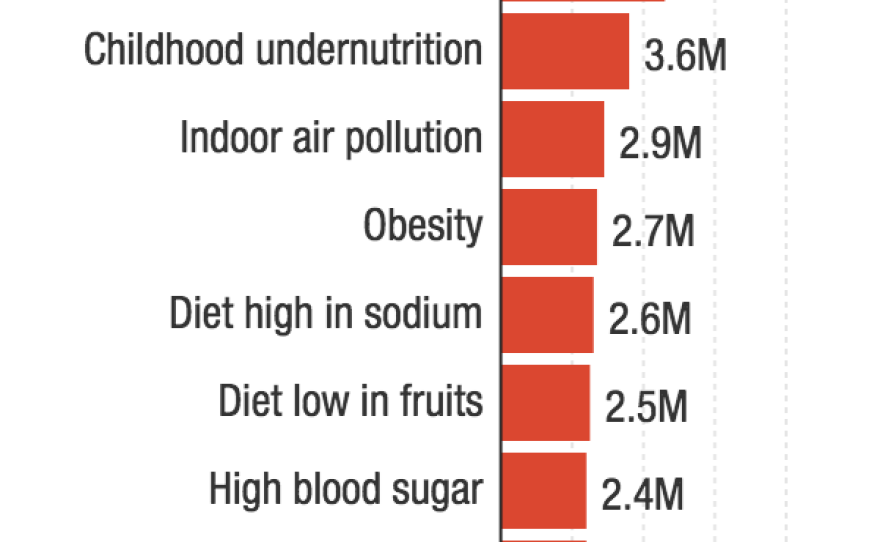

There has been a profound — and positive — change since 1990 in how people die around the world, a new study shows. "We've made great progress in reducing the risks of maternal and child health, diarrhea, pneumonia, though there's still more work to be done," says Dr. Alan Lopez, author of a global analysis of risk factors of death published this week in the journal The Lancet. Since 1990, childhood malnutrition and unsafe water have fallen off the top ten causes of death around the world.
"The natural consequence of that is that more babies are living to adolescence and adulthood," says Lopez, chair of Global Health and Burden of Disease Measurement at the University of Melbourne. "It's reminding governments that they also have to keep those adolescents alive and well into old age."
And that's where the bad news of the global health report comes in. High blood pressure, which leads to heart attacks and strokes, is still the leading cause of death, and smoking is number two. And obesity has crept up the list from number five to become the third most prevalent risk factor for premature death around the world. Now those and other lifestyle factors, like high cholesterol, high blood sugar, diets low in fruits and high in salt, and alcohol use make up eight of the top ten risks for early death.
"From the risks we've identified and quantified, just under 60 percent of premature deaths are preventable," says Lopez.
We asked Lopez to comment on some of the report's major findings:
In much of the Middle East and Latin America, high body mass index is the number-one risk associated with health loss.
The prevalence of obesity in the Middle East, Latin America, and also Eastern Europe is going to be a public health time bomb. My sense is that women in these societies have a very protected role. They're not encouraged to exercise or even to walk. But they're probably also eating too much, and my suspicion is that their diet is increasingly rich in sugar and fats. This is true for men, too.
In South and Southeast Asia, household air pollution is a leading risk, and India also grapples with high risks of unsafe water and childhood undernutrition.
In South and Southeast Asia, the tradition has been to [use fossil fuel like coal and wood for] indoor cooking and heating. That creates high risk. It's likely that as these regions get wealthier, they will change the way they heat and cook and that will lower their health risks.
The finding that India is still grappling with unsafe water and childhood undernutrition are reminders that, while we're making great progress in reducing risks, still India and much of Africa have malnutrition as a major risk factor.
Alcohol is the number two risk factor in Russia.
That hasn't changed much. Alcohol has been prevalent in Russian society for decades. But we can't underestimate its importance. It dramatically shortens the lifespan.
Smoking is the number-one risk in many high-income countries, including the United Kingdom and the United States. The rate of smoking-related deaths among men in the U.S. has remained stagnant but has risen by more than 26 percent among women.
The U.S. is a very good example of what's happened with smoking. Male smoking peaked in the 1980s and then started declining. You can see declines in men's deaths due to smoking now. But women started smoking two to three decades after men, and we're not yet seeing the declines in women that we see in men.
In the U.S., large sections of the population do not get access to preventive services or do not heed preventive messages. This is a wake up call. This risk could be addressed more aggressively. For example, in Australia, we have plain packaging on cigarettes [with slogans like "smoking kills."] Continued efforts to repress tobacco use in Australia have brought smoking rates down to 12 to 15 percent. In the immediate post-war era, the rate among men was 70 percent. [In the U.S., current smoking rates are about 18 percent, according to the Centers for Disease Control and Prevention.]
In sub-Saharan Africa, people are simply not living long enough to fall prey to high blood pressure and are too poor to suffer from obesity. Unlike other regions, its greatest risk factors for death are a combination of childhood malnutrition, unsafe water and lack of sanitation, unsafe sex and alcohol use.
We've made huge progress against many of those risks in the West. [But] there has been slow progress in Africa. This represents a failure in health systems, a failure in governments. We have methods of controlling mortality and disability from HIV/AIDS [with antiretroviral drugs], and of providing preventive education. But health systems need to be able to afford it.
This interview has been edited for length and clarity.
Copyright 2015 NPR. To see more, visit http://www.npr.org/.






